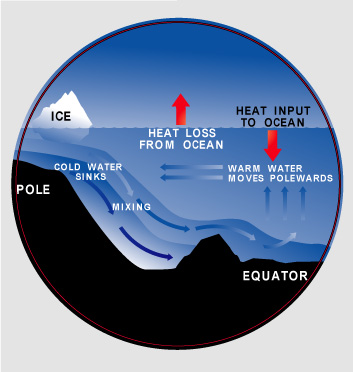Covering around 2/3 of the Earth’s surface, water absorbs about twice as much the amount of solar radiation. Ocean currents move massive amounts of heat across the Earth through channels therefore being able the change the climate of countries easily.

Theory of ocean circulation
The basic theory of the ocean circulation works like this. The cold water from the Poles of the Earth sinks and moves towards the equator. As the water travel, it is observed that the cold water heats up and travels back to the poles. When it reaches the poles, it gets cooled down again and moves back towards the equator. This same circulation of water is also seen at the equator with warm water moving towards the pole and back to the equator.
These 2 circulations are only the more standard examples. There are also many other factors that can affect the ocean circulation. The movement of water can also be affected by winds pushing them on the surface. Therefore the circulation of water is not very even and may be constrained on certain regions. This would affect the overall temperature of the Earth as heat is not evenly spread out. As a result, certain areas may be more humid, have more rain.
If the situation worsens, the ice from the poles would all melt and result in a huge disturbance in the ocean circulation patterns of the water. It would also affect the humans due to the rise in sea level causing floods and many other natural disasters.
Much of the heat from the waters escapes in the form of water vapour which is also one of the greenhouse gases. The ocean circulation also has an indirect effect on the emission of carbon dioxide.
